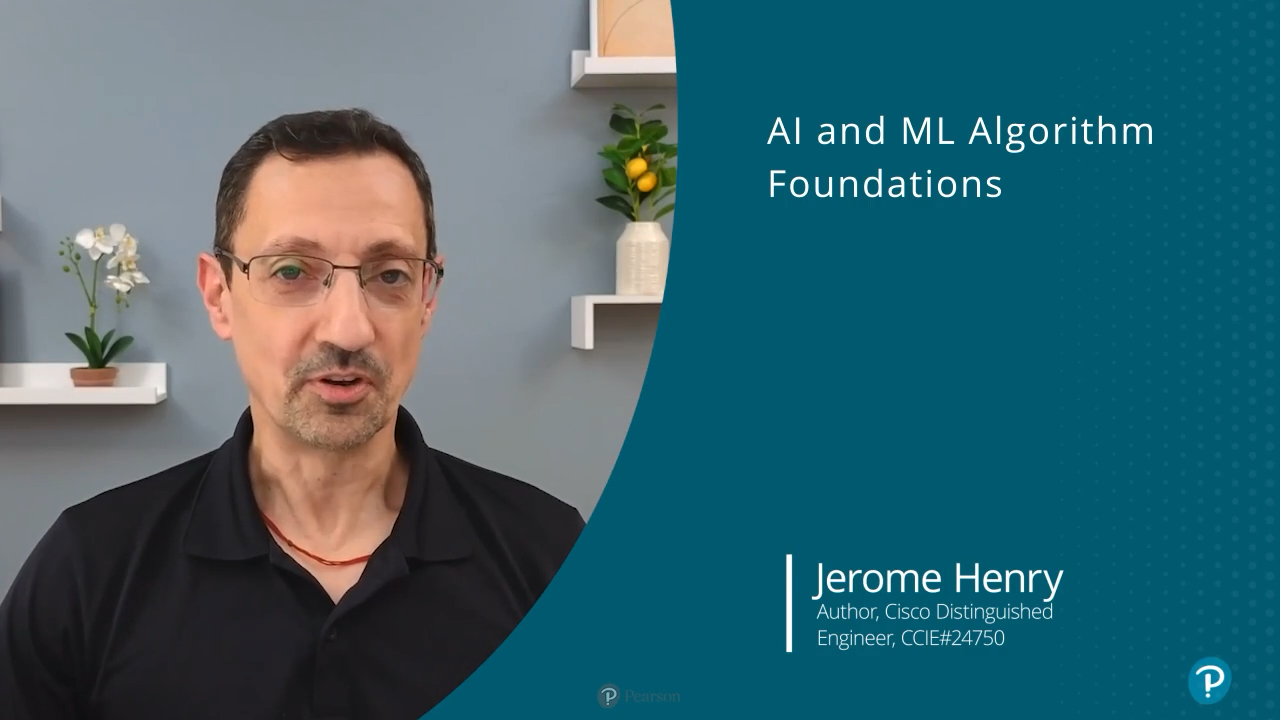AI & ML Foundations (Video Course)
- By Robert Barton, Jerome Henry
- Published Oct 14, 2024 by Addison-Wesley Professional.

Online Video
- Your Price: $239.99
- List Price: $299.99
- About this video
Video accessible from your Account page after purchase.
Register your product to gain access to bonus material or receive a coupon.
Description
- Copyright 2025
- Edition: 1st
- Online Video
- ISBN-10: 0-13-535812-4
- ISBN-13: 978-0-13-535812-2
A non-mathematician's and data science beginners' course to how AI algorithms work and how to use them in practice.
Overview:
4 hours of video training
- Learn how AI algorithms work, including large language models (used by ChatGPT), deep learning, reinforcement learning, and unsupervised learning
- See examples of how these algorithms work through intuitive live demonstrations
- Use development kits such as Tensorflow, Pytorch, and Sckitlearn
- Get real-world, practical hands-on examples using Python and Jupyter Notebook so you can get started with your own AI projects right away
AI & ML Foundations demystifies the world of AI and LLMs. It teaches you how to apply the tools of Artificial Intelligence Markup Language (AI/ML) to solve problems faster, automate processes, find hidden patterns, and accelerate your work. Additionally, you will get an inside look into the world of AI, learning about passcode terms like LLMs, ChatGPT, TensorFlow, and Pytorch, along with explanations and examples that clarify what the many underlying algorithms, such as K-Means, SVM, XG Boost, and DBSCAN can do.
Related learning
- Sign up for "AI and ML Algorithms for Non-mathematicians and Data Science Beginners" by Rob Barton and Jerome Henry: https://learning.oreilly.com/search/?q=Rob%20Barton%20and%20Jerome%20Henry%20AI%20and%20ML%20Algorithms%20for%20Non-mathematicians%20and%20Data%20Science%20Beginners&type=live-event-series&publishers=Pearson&rows=10
Skill Level
Intermediate
Course Requirement
None
About Pearson Video Training
Pearson publishes expert-led video tutorials covering a wide selection of technology topics designed to teach you the skills you need to succeed. These professional and personal technology videos feature world-leading author instructors published by your trusted technology brands: Addison-Wesley, Cisco Press, Pearson IT Certification, Sams, and Que. Topics include IT Certification, Network Security, Cisco Technology, Programming, Web Development, Mobile Development, and more. Learn more about Pearson Video training at http://www.informit.com/video.
Video Lessons are available for download for offline viewing within the streaming format. Look for the green arrow in each lesson.
Sample Content
Table of Contents
Lesson 1: An Introduction to the World of Artificial Intelligence and Machine Learning
1.1 A Brief History of AI and ML
1.2 AI and ML Definitions
1.3 Discriminative / Predictive vs. Generative AI
Lesson 2: Unsupervised Learning
2.1 Clustering Principles
2.2 How K-means Works, Advantages and Limitations
2.3 Hierarchical Clustering
2.4 DBSCAN for Complex Shapes
Lesson 3: Supervised Learning
3.1 Predictive Functions
3.2 Linear Regression Fitting a Curve with Training Data
3.3 The Cost Function
3.4 Gradient Descent
3.5 The Machine Learning Workflow
3.6 Classification 1 Logistic Regression
3.7 Classification 2 - Support Vector Machines (SVM)
Lesson 4: Random Forests
4.1 Why Use Trees?
4.2 Build Your First Tree
4.3 Build a Full Forest
Lesson 5: Reinforcement Learning
5.1 Why Reinforcement Learning
5.2 Understanding Reinforcement Learning Components and Framework
5.3 The Bellman Value Equation
5.4 Q-Learning
Lesson 6: Deep Learning
6.1 Why is this Learning "Deep"?
6.2 Artificial Neural Networks (ANN) Step-by-step
6.3 Convolutional Neural Networks (CNN) for Image Recognition
Lesson 7: An Introduction to Large Language Models
7.1 How did Large Language Models (LLMs) Develop?
7.2 Word Embedding
7.3 Transformers
7.4 Advanced Topics
More Information
